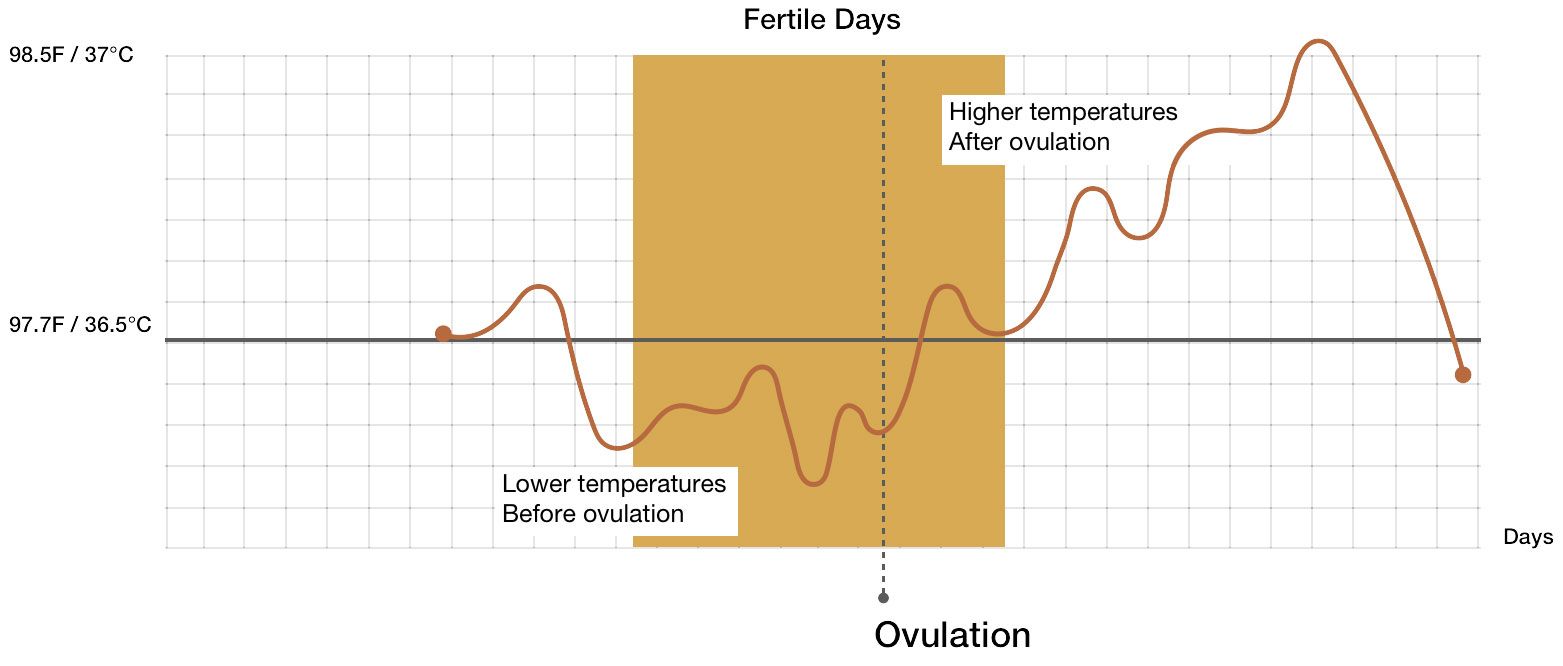What is fertility awareness? How to track fertility using basal body temperature.


Fertility Awareness Methods (FAMs) refer to one of several methods that use the natural variation in the human body’s periodic rhythms/cycles to track fertility. Monitoring cyclic physiological changes in order to track fertility is a practice that dates back millennia. However, in the light of modern scientific advances, not only have the number of such methods at our disposal increased, but the processes underlying them have been understood more empirically.
What is fertility awareness?
Every month, a woman’s reproductive system undergoes a series of hormone mediated changes, that make it possible for pregnancy to occur. In the first phase of the menstrual cycle (follicular phase), estrogen levels rise gradually, resulting in the thickening of the uterine lining (to prepare for a possible pregnancy) and the growth and development of the oocyte (egg). Around the 14th day,the fully developed egg is released (Ovulatory phase) and is either fertilized by a sperm, resulting in a pregnancy, or is discarded along with the lining of the uterus, resulting in a period (luteal phase).
Usually, the egg is viable for about 24 hours after release. Male sperm cells, however, survive in the female reproductive tract for up to 6 days. So, chances of pregnancy are high, starting from the day before ovulation, lasting up to 6 days after ovulation.
Fertility awareness methods use physiological indicators to track the time of ovulation and by extension, the 5-7 days of the month when a woman has the highest likelihood of pregnancy.
Women might choose to track their fertility for a number of reasons:
- To avoid pregnancy. I.e as a method of contraception
- To time intercourse during ovulation, in order to achieve pregnancy
- To predict their periods
- To establish the presence of an imbalance/ disorder of the reproductive system.
“Basal body temperature (BBT) refers to the lowest temperature of the body, during a state of complete rest (deep sleep). Usually, a temperature reading taken immediately after waking up, even before getting out of bed, is the closest to the basal body temperature”
What are the various forms of fertility awareness?
- Temperature method
- Cervical mucus method
- Calendar method
- When basal body temperature, cervical mucus and cervical position are monitored together to track fertility, it is known as the “Sympto-Thermal Method” (STM).
What is basal body temperature?
Human body temperature is in a state of constant flux. The body constantly undergoes subtle changes in temperature, reflecting its metabolic patterns. Any number of factors such as exercise, food intake, sleep/wakefulness, stress levels, external temperature and so on, have a measurable impact on body temperature.
Basal body temperature (BBT) refers to the lowest temperature of the body, during a state of complete rest (deep sleep). Usually, a temperature reading taken immediately after waking up, even before getting out of bed, is the closest to the basal body temperature (although it is still slightly higher than the BBT).
Because there is so much variability in body temperature, it is vital that the readings used to track your monthly cycles pertain as closely as possible to the BBT and that there is as little variation as possible between them.
Basal body temperature and fertility
- During the pre-ovulatory phase of the menstrual cycle, the increased levels of estrogen make for a lower basal body temperature - usually, well below 36.8°C [98.6 °F].
- Just before the egg is released, the BBT further dips slightly, reflecting the peak concentration of Luteinizing Hormone (LH).
- And then about 24 hours after ovulation, the higher levels of progesterone released by the corpus luteum raise the BBT by 0.2-0.3°C. This elevation typically lasts until the following menstruation period.

Most women record temperatures between 36.11-36.38°C [97-97.5°F] before ovulation and 36.44 to 37°C [97.6-98.6°F] right after ovulation, for up to 72 hours, unless pregnancy occurs, in which case, the elevation lasts throughout the first trimester.
Is It Effective?
Studies show that using BBT charts to track fertility has about a 99% success rate in the first year that most women use it (if done properly). However, following the first year, the success rate drops to about 85%. It is assumed that this is because of reduced assiduousness and care after the initial period.
BBT charting continues to be a widely used method to track fertility, owing to its affordability, universality and relative simplicity. It is vital to remember however, that there is no such thing as a universally ideal BBT curve. Every woman’s cycle bears its own little idiosyncrasies, which only come to light when the charting is done consistently over a period of time. It is only within the framework of a woman’s unique curves that useful trends are observed.
How to Chart BBT?
- You have to measure your temperature every morning, immediately after you wake up, before you move or get up out of bed.
- The reading has to be taken at about the same time every day; Although some sources say a discrepancy of no more than 30 minutes is probably alright, the accuracy of the method is definitely much more reliable if the time of the readings is kept as constant as possible. Needless to say, the same thermometer needs to be used to obtain the readings.
- It is essential to get at least 3-4 hours of sleep before you take a reading. If you’ve stayed up all night, the reading taken during the usual time in the morning is to be considered null and void.
- Note down your readings on an ovulation chart (or on an online or mobile alternative).
- The longer you track your cycle with meticulous care and regularity, the more accurate it will be with the information it gives you.
Identifying Ovulation
You shouldn’t be surprised to see numerous tiny peaks and troughs in your chart. However do bear in mind that you are looking out for a “curve”. I.e you are looking to find a biphasic pattern that has an ascending and descending trend. This means that after ovulation, the average temperature readings tend to be higher than average readings taken before ovulation.
Three consecutive, above-average readings usually indicate that ovulation probably occurred before the first high reading.
Abnormal Curves - What Do They Mean?
Generally, as a thumb rule, before you panic about your curve being abnormal, it is advisable to check if your thermometer might be faulty. Additionally, digital thermometers may give slightly-off readings for upto a month before their batteries die.
- Monotonous Curve - A curve with no increase or decrease in average BBT, over a month, indicates that ovulation has not taken place.
- Zig-Zag Curve and Erratic Curve- These curves indicate a seemingly haphazard rise and fall of BBT over a month. They usually are a sign of estrogen deficiency. If you have notice such curves in your chart, it is advisable to consult your gynaecologist immediately.
Do I Need a Basal Body Thermometer To Chart My Cycles?
No, not necessarily. Although basal body thermometers are especially marketed towards women who are looking to chart their monthly cycles, any thermometer that is accurate and easy to read to within 1/100th of a degree, (if you use celsius - or 1/10th of a degree, for fahrenheit) can be used.
However, basal body thermometers do come with specialised features that might make them appealing for charting. Nevertheless, you might just find that a few frippery features don’t really justify the prices at which these thermometers are sold.
The Future
The future of healthcare is definitely one that minimises human effort and in turn, error. There is no doubt that medicine is rapidly moving towards a big-data revolution. The consumer of tomorrow will have to do/worry about less and conversely, will have access to more.
A slice of the future is here - With ONiO, collecting and charting your BBT, readings could not be easier. Readings are collected and tabulated constantly, to reflect trends in your temperature.













